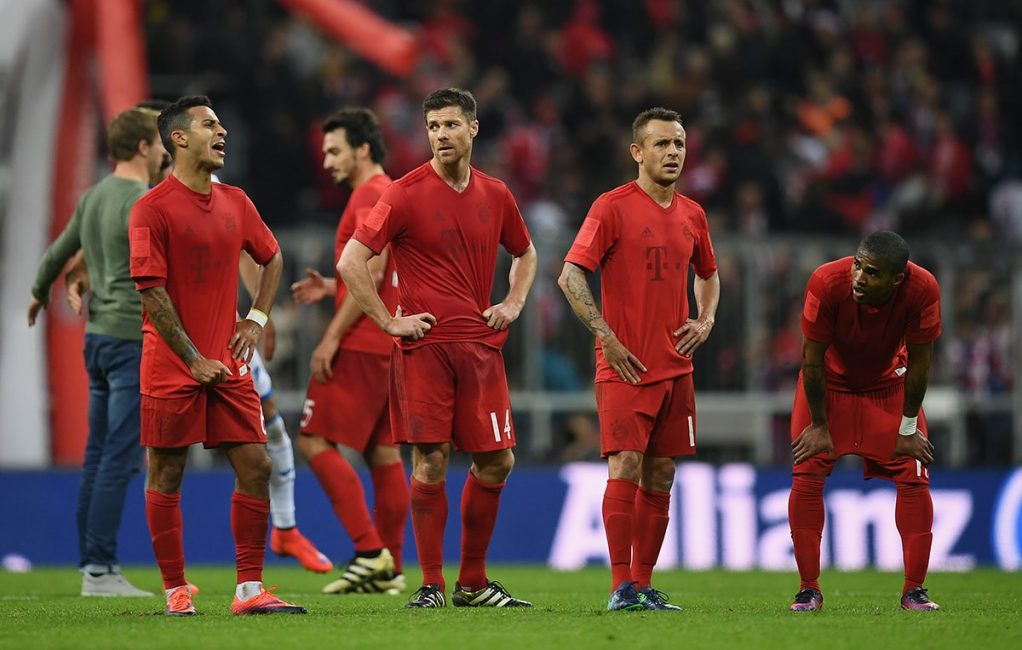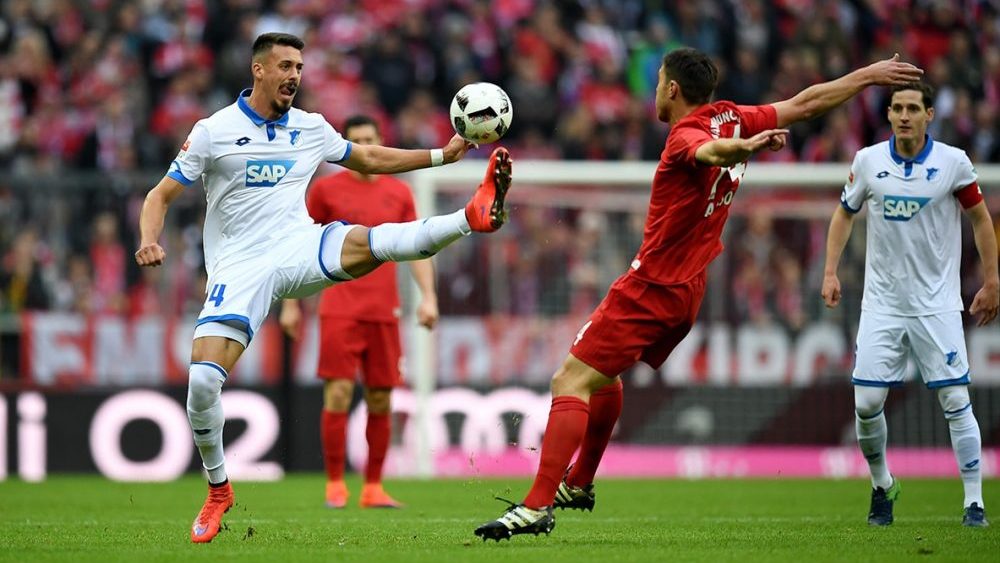Bridge over troubled midfield: Alonso’s issues
The public image of Xabi Alonso over the last couple of days and weeks has been a sad one: the 34-year-old seems helpless at times and makes mistakes that he wouldn’t usually make. But he’s not the only one responsible for that situation. A comment.
It was aforementioned game against TSG Hoffenheim that revealed Bayern’s issues with high pressure in the first half and clearly showcased Xabi Alonso’s weaknesses. However, it’s not exactly breaking news that the midfielder is a little slow.
In other non-news: he doesn’t always handle pressing situations well, and he often looks bad when he’s left alone in defensive midfield to work against the ball.
So how could a player with all these many, obvious weaknesses play such an important role over the last two years? And why does he not have that role anymore? Both questions can’t just be answered with “bad form” – there’s much more going on besides that.
Alonso needs the right set-up
The former Spain international has won almost everything. He had a role that was both dominant and noticeable for Liverpool, Real Madrid, and Spain, and now at Bayern. He used to be able to create that dominance on his own; controlling a game and setting the pace even though opposition was putting him under pressure. This has changed with age; he was never the fastest player around, and so it only becomes more obvious now when he loses pace even more towards the end of his career.
However, Alonso has abilities that only very few players in Europe have: he can dominate, control, and open up a game, both vertically and diagonally.
Back to Saturday afternoon, back to Munich. Alonso, with no pressure on him, gets the ball in the centre circle, and sees Thomas Müller, who’s making a run to free up some space for himself. Bayern’s number 14 plays a pass that cuts through almost all of Hoffenheim’s team, right to the striker, who moves the ball to Hummels – who hits the post. It almost was the game’s decisive moment. It is this genius of the midfield director that shines through again and again, even in weaker games.
Vision, important shifts of play across the field, vertical play – all of these were strengths that distinguished Alonso over the last two years.
But Bayern’s style of play has changed a fair bit. Players are positioning themselves differently, not occupying zones as thoroughly as they used to. Guardiola knew about the Spaniard’s weaknesses, of course, but he was able to conceal them by positioning Alonso in a way that always gave him at least four options around him.
Lahm, drifting inwards, and one to two offensive players made sure that opposing teams’ pressing efforts were pulled wide. On the one hand, this ensured that there was always a passing option, on the other, pressure wasn’t quite so high. In the first and second third, the record champions’ game was focused, among other things, on taking pressure off Alonso.
It’s easy to forget that Alonso was one of the best players in the semi-final games against Atlético: winning 1-on-1s, controlling Bayern’s game, and making it more vertical against a team that defends very effectively, tightly, and high up the pitch, especially in the centre. Alonso was a counter pressing weapon – by design. There were plenty of occasions in the past two years with similar performances.
This season, though, he often seems lost in counter pressing. He often moves up and then simply gets bypassed. “It’s not Alonso’s game when he has to chase someone,” Guardiola once said. Again, team tactics are an important factor to keep in mind: over the last couple of years, the team defended very high up the pitch.
Counter pressing was the key to success and Alonso was the key to controlling the midfield. He seems overwhelmed with that at the moment, however, and Bayern rarely have an effective grasp on the game after losing the ball in attack. Vidal and Thiago, in particular, like to attack early and move up despite unfortunate positioning, leaving behind a large hole that is suddenly filled with only a single defensive midfielder.
Alonso isn’t the only one struggling with that; Thiago and Kimmich had similar issues this season when playing that position.

3-2 or 3-3 formation to improve build-up play
In order to include the Spaniard better, the structure needs to be changed. He is overwhelmed and redundant in the current one; centre-backs and offensive midfielders form a rectangle with Alonso in the middle, left alone more often than not, making it easy for opposing teams to take him out of the action.
The solution is him dropping back between the defenders, turning the formation into a 3-2 that was effective against Hoffenheim on those occasions when it happened accidentally.
But even with that, Alonso isn’t really needed: Boateng and Hummels prefer the more direct pass forward anyway. So the real solution to the problem would be positioning Alonso further up, one of the full-backs moving into a more central position, the other one forming the back three to weaken the opponent’s pressing.
The offensive midfielders then position themselves in the available half-spaces and form triangles with the other players. This way, playing with Alonso in the team worked much better.
Somebody needs to take guide Xabi, put him in the right spot, and, most of all, emphasise his strengths. At the moment, it seems like too many tasks in midfield are heaped onto his shoulders, and his weaknesses aren’t hidden anymore. The fact that he’s playing a lot (13 of 17 games so far this season) surely isn’t helping, either; his mistakes become more frequent the more subsequent games he plays. The former World Champion is an expert who needs his batteries fully charged to run on full power.
Without a doubt, lack of form is also one of the factors that contribute to him not playing at his usual standard, and this comment is not looking to hide that. However, the roots of that particular evil lie in lack of support, a changed formation that doesn’t support him as well, and an exaggerated public focus. The game against Hoffenheim showed an overchallenged midfielder in the first half, incapable of removing himself from pressing, and starting dangerous counterattacks for the opponent; a player who lacked options and who had hardly any support from his team mates.
In the second half, a tactical metronome showed up, not hiding despite all the difficulties. One who asked to receive balls but also knew when to remove himself from the game with intelligent movements. Most of all, somebody who can still play an important role for FC Bayern with passes like the one to Thomas Müller just before the end of the game.












As carlo said “doesn’t care if Xabi runs slowly – once he can make the ball move quickly”…i think we need someone who can do both at the same time!